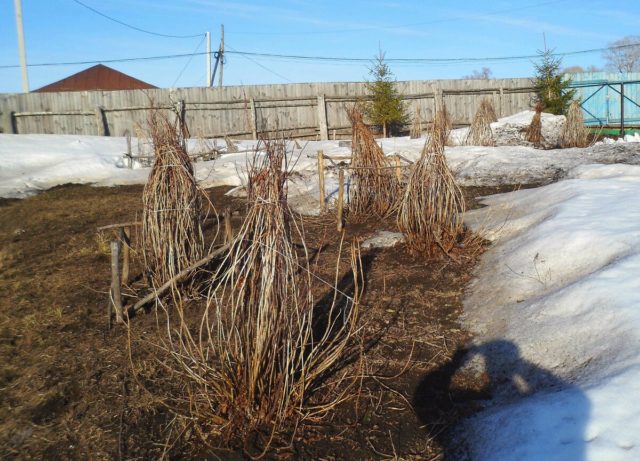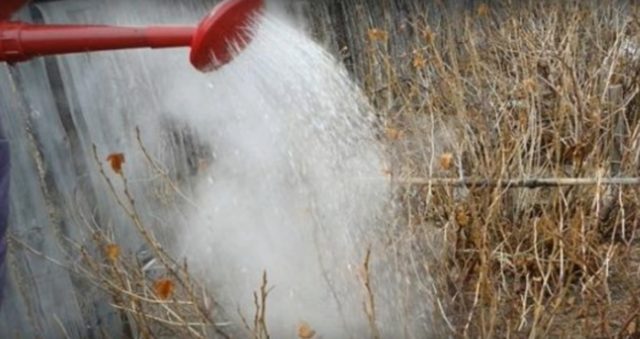Content
The agrochemical industry offers a wide range of preparations for protecting berry crops from pests; prevention plays an important role in the fight against parasitic insects. Treatment of currants in spring with boiling water will help to destroy hibernating larvae and speed up the growing season.
Why pour boiling water over currants
Processing currant bushes in spring with boiling water is a multifunctional procedure. It will help eliminate harmful insects and speed up the flow of sap. The berry crop is grown throughout Russia, the shrub is undemanding to care, and is highly frost-resistant. Many varieties have strong immunity to infection, but all pests are affected, regardless of the color of the berries.
The list of insects parasitizing on the berry culture in each climatic zone is different, but there are species for which severe or warm winters do not become an obstacle to reproduction. These include the species of mites. Insect larvae hibernate under bark, in buds, dry leaves near berry bushes or in the upper layers of the soil. Heat treatment is carried out for the following purposes:
- for the destruction of mite larvae and spores of the powdery mildew fungus;
- to improve the resistance of currants to disease;
- to speed up the sap flow;
- processing in spring has a positive effect on the level of fruiting;
- after the procedure, the size of the berries increases and the taste improves.
Watering in spring with boiling water is especially relevant for black currants. All varieties have a smell characteristic only of black currants, it is he who attracts pests.
Heat treatment causes stress, the plant comes out of dormancy, the mechanism of biological processes is triggered. The buds will begin to bloom, the bush will begin to gain strength for further vegetation. And also watering currants with boiling water in early spring will protect the plant from possible return frosts.
When to process currants with boiling water
In each climatic zone, the time of the onset of spring is different. Processing of currants in the European part takes place approximately in April. In the middle lane in the middle or at the end of the first month of spring. In the southern regions, processing is possible even in February.
The main requirement for heat treatment is that the plant is at rest before the onset of sap flow. They determine the state of the kidneys, if they have increased in size and become lighter, then they will soon bloom. This time is not suitable for watering currant bushes with boiling water, treatment will only bring harm, damaged buds may crumble, the bush will not yield a crop.
It is better to spill currants with boiling water on a sunny day. Heat treatment will destroy pests, and warm weather will accelerate the onset of sap flow.
It makes no sense to water currant bushes with boiling water at the end of the growing season. Treatment in late autumn will be effective only against aphids, it will not harm the kidney mite. Not all mites are on the plant, the larvae go deep into the bark of the bush and buds, the surface of the buds is covered with a hard shell, perhaps even a layer of ice and hot water cannot harm insects.
How to properly spill currants with boiling water
The processing of currants in the spring is carried out after the snow has melted and certain preparatory work:
- All berry bushes are inspected and sanitized.
- Bent old branches are removed.
- Cut off the stems damaged by frost and dry areas.
- Abnormally large kidneys are removed, and the main accumulation of mites will be in them.
- After pruning, the branches are pulled into a bunch and fixed with a rope.
A compact bush is much easier to handle. It is necessary to protect the root from burns, it is covered with any available material.
It is recommended to spray currants with boiling water in spring with a watering can with small cells.
If there is no watering can, processing can be carried out using a ladle, water should be poured in small portions, but quickly so that the temperature does not drop. But this does not mean that in spring currants need scalding with boiling water. The water temperature should be within 60-80 0C.
This point is important, if the temperature is lower, there will be no positive result either in terms of pest control or to accelerate the growing season. Too high temperature will kill insects but burn buds and stems. The plant will take a long time to recover and will not yield a crop.
It is recommended to measure water with a thermometer, if the bushes are located at a great distance from the building, it is necessary that there is spare hot water with its help, you can correct the temperature. Processing sequence in spring:
- Water is poured into a watering can, the temperature is measured, if cold is added above the norm, hot below it.
- Water should be poured only on the shrub, the treatment should cover the crown completely so that there are no dry places left.
- Watering time for each site is no more than 4-5 seconds.
- The distance from the branches to the watering can or bucket is 10 cm.
Hot water consumption is 1 bucket per 2 bush. The norm is average, the amount depends on the diameter of the currant. The main task is to ensure that the treatment covers all areas and does not harm the plant.
Experienced gardening tips
The preventive method of pouring boiling water over currants in spring is not innovative. It has been used by more than one generation of gardeners for many years. The method of pest control is environmentally friendly, financially inexpensive, and gives good results. If the procedure is carried out correctly in the spring, it turns out to get rid of ticks and fungal spores, to increase the quantity and quality of berries.
A few tips from gardeners with many years of experience in growing crops will help achieve the best result of treating shrubs in spring with hot water:
- Sanitary currant pruning is preliminarily carried out.
- For the effectiveness of heat treatment, manganese can be added to the water so that the solution turns out to be pale pink, copper sulfate or baking soda.
- Be sure to observe a certain temperature indicator, the water is below 600 not useful, above 800 injures the currant.
- Processing should be fast.
- You cannot pour water at the root, at the same time it is recommended to shed soil near the shrub.
- It is better to use a metal watering can rather than a plastic one.
Swollen buds are removed from the bush, there will certainly be an accumulation of mites in them. It is necessary to carry out processing in early spring.
Conclusion
Processing currants in spring with boiling water is an effective method against ticks, hibernating larvae, and fungal spores. The plant quickly reacts to a sharp change in temperature, comes out of dormancy, and resumes sap flow. The procedure strengthens the resistance of the berry bushes to infection, increases yields, relieves the gardener from the need to use chemicals in the fight against pests.










